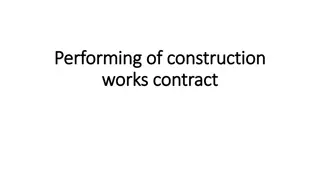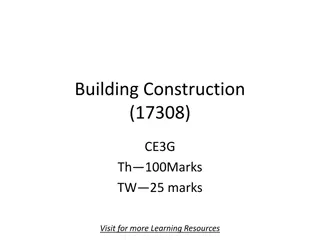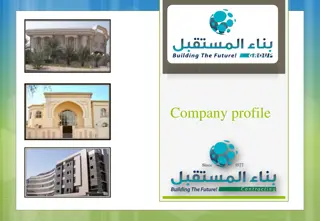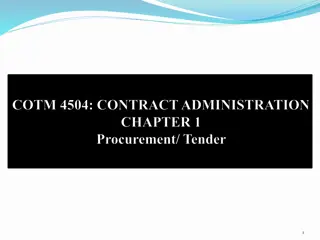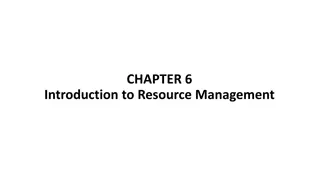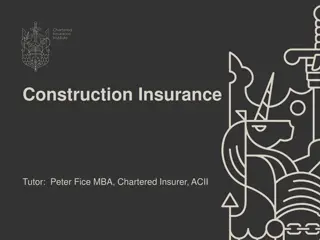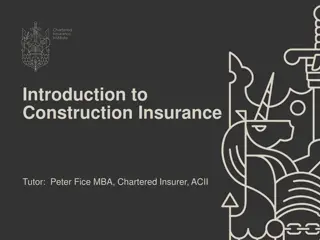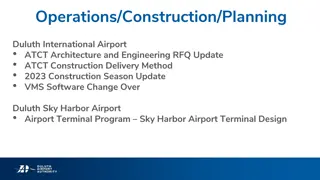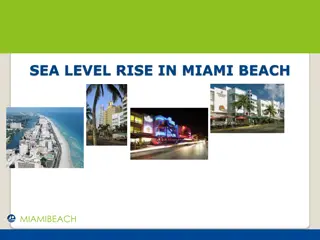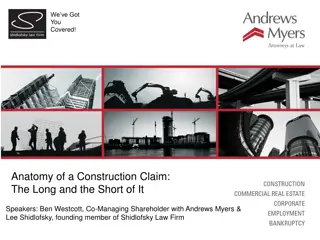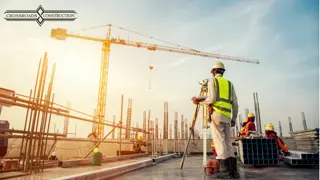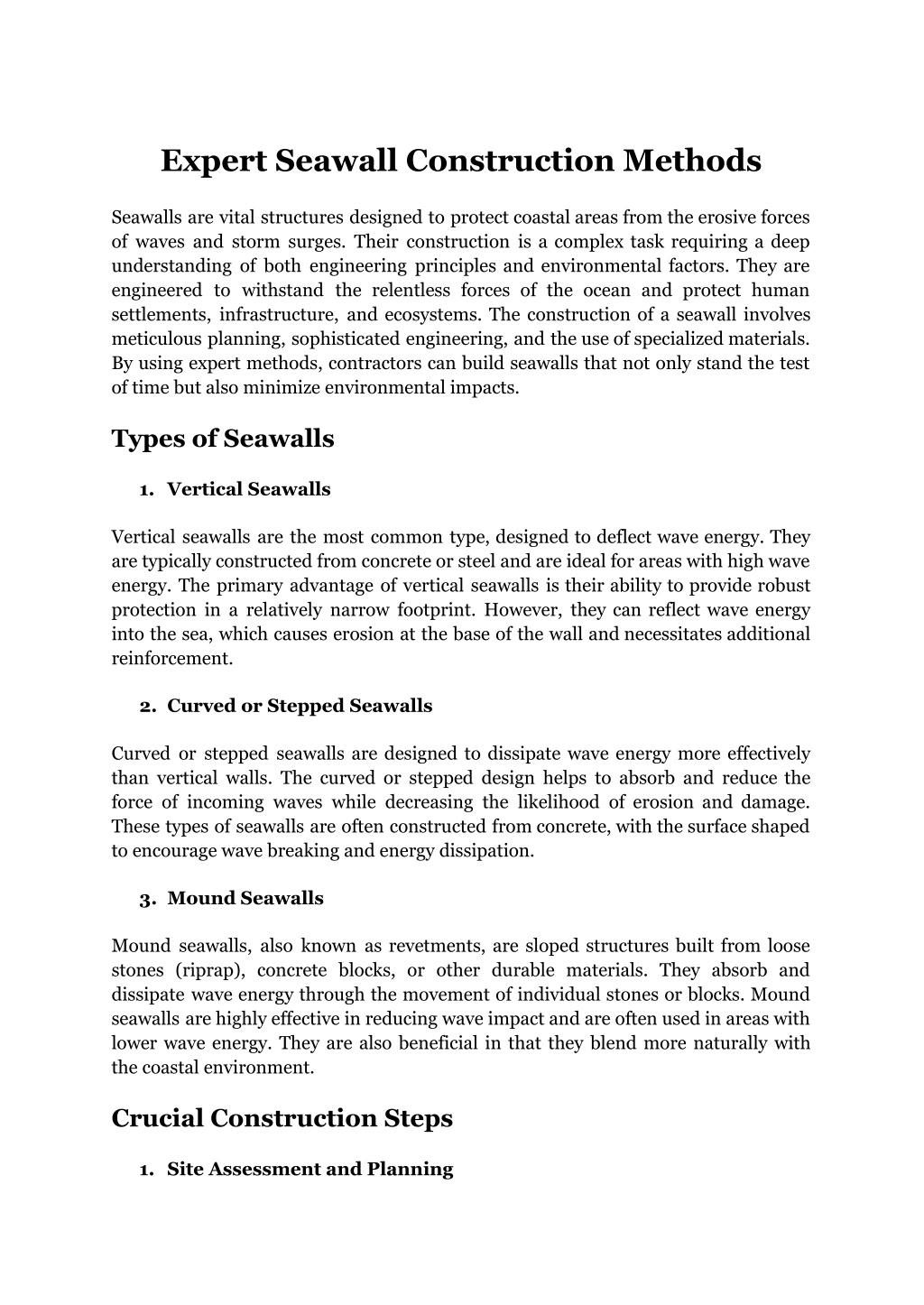
Expert Seawall Construction Methods
A stable foundation is crucial for the longevity of a seawall. For vertical and curvednseawalls, this necessitates excavating to a suitable depth and constructing a basenfrom reinforced concrete or steel pilings. The foundation must be capable ofnsupporting the weight of the seawall and resisting the forces exerted by waves andntidal movements. In some cases, ground improvement techniques, such as soilnstabilization or the use of geotextiles, are utilized by excavating contractors innIvoryton CT to enhance the bearing capacity of the foundation.
Download Presentation

Please find below an Image/Link to download the presentation.
The content on the website is provided AS IS for your information and personal use only. It may not be sold, licensed, or shared on other websites without obtaining consent from the author. If you encounter any issues during the download, it is possible that the publisher has removed the file from their server.
You are allowed to download the files provided on this website for personal or commercial use, subject to the condition that they are used lawfully. All files are the property of their respective owners.
The content on the website is provided AS IS for your information and personal use only. It may not be sold, licensed, or shared on other websites without obtaining consent from the author.
E N D
Presentation Transcript
Expert Seawall Construction Methods Seawalls are vital structures designed to protect coastal areas from the erosive forces of waves and storm surges. Their construction is a complex task requiring a deep understanding of both engineering principles and environmental factors. They are engineered to withstand the relentless forces of the ocean and protect human settlements, infrastructure, and ecosystems. The construction of a seawall involves meticulous planning, sophisticated engineering, and the use of specialized materials. By using expert methods, contractors can build seawalls that not only stand the test of time but also minimize environmental impacts. Types of Seawalls 1. Vertical Seawalls Vertical seawalls are the most common type, designed to deflect wave energy. They are typically constructed from concrete or steel and are ideal for areas with high wave energy. The primary advantage of vertical seawalls is their ability to provide robust protection in a relatively narrow footprint. However, they can reflect wave energy into the sea, which causes erosion at the base of the wall and necessitates additional reinforcement. 2. Curved or Stepped Seawalls Curved or stepped seawalls are designed to dissipate wave energy more effectively than vertical walls. The curved or stepped design helps to absorb and reduce the force of incoming waves while decreasing the likelihood of erosion and damage. These types of seawalls are often constructed from concrete, with the surface shaped to encourage wave breaking and energy dissipation. 3. Mound Seawalls Mound seawalls, also known as revetments, are sloped structures built from loose stones (riprap), concrete blocks, or other durable materials. They absorb and dissipate wave energy through the movement of individual stones or blocks. Mound seawalls are highly effective in reducing wave impact and are often used in areas with lower wave energy. They are also beneficial in that they blend more naturally with the coastal environment. Crucial Construction Steps 1. Site Assessment and Planning
The first step in seawall construction is a thorough site assessment. Engineers must understand the local wave dynamics, Professionals conduct geotechnical surveys, environmental impact assessments. The data gathered during this phase informs the design and construction plan, ensuring that the seawall will be effective and sustainable. tidal patterns, hydrodynamic and soil conditions. modeling, and 2. Foundation Preparation A stable foundation is crucial for the longevity of a seawall. For vertical and curved seawalls, this necessitates excavating to a suitable depth and constructing a base from reinforced concrete or steel pilings. The foundation must be capable of supporting the weight of the seawall and resisting the forces exerted by waves and tidal movements. In some cases, ground improvement techniques, such as soil stabilization or the use of geotextiles, are utilized by excavating contractors in Ivoryton CT to enhance the bearing capacity of the foundation. 3. Material Selection The choice of materials is a critical aspect of seawall construction. Because of its strength and longevity, reinforced concrete is used for seawalls that are curved or vertical. Steel sheet piles are also a popular choice for their resistance to corrosion and ease of installation. Interlocking concrete blocks riprap, or huge stones, are commonly used for mound seawalls. The materials must be chosen based on their ability to withstand the harsh marine environment and the specific wave energy conditions of the site. Construction Techniques 1. Pile Driving Pile driving is a common technique for seawalls that demand deep foundations. Steel or concrete piles are driven into the ground using hydraulic hammers or vibratory drivers. This method provides a strong and stable foundation, especially in areas with loose or unstable soils. The piles help to distribute the load of the seawall and resist the lateral forces exerted by waves. 2. Casting and Placement of Concrete In the construction of vertical and curved seawalls, concrete is often cast in situ (on-site). Ivoryton excavating contractors set up formwork to shape the seawall and pour concrete into the forms. The concrete is properly cured to achieve maximum strength and resilience. In some cases, precast concrete blocks or panels are used,
which are manufactured off-site and then transported and assembled at the construction site. 3. Rock Placement for Mound Seawalls Layering huge rocks or concrete blocks is the major step in the process of building a mound seawall. The base layer typically consists of larger stones to provide stability, while the upper layers are composed of smaller stones to absorb and dissipate wave energy. The placement of rocks must be carefully managed to ensure interlocking and stability, preventing movement under wave action. Environmental Considerations 1. Minimizing Impact Seawall construction can have significant environmental impacts, including habitat disruption and changes in coastal dynamics. To minimize these impacts, it is essential to conduct thorough environmental assessments and implement mitigation measures. This may include designing the seawall to accommodate natural coastal processes, using environmentally friendly materials, and restoring vegetation and habitats disturbed during construction. 2. Long-term Monitoring and Maintenance Once a seawall is constructed, ongoing monitoring and maintenance are critical to ensure its effectiveness. Regular inspections can identify signs of wear and damage, such as cracks, erosion, or settlement. Commercial excavating contractors in CT engage in repairing damaged sections, reinforcing foundations, and replacing worn materials. By maintaining the seawall, its lifespan can be extended, and its protective functions preserved. Conclusion As climate change continues to exacerbate coastal erosion and sea level rise, the importance of expertly constructed seawalls will only increase, which makes them a vital component of coastal resilience and protection strategies. By selecting appropriate materials and choosing robust construction methods, contractors can build seawalls that provide long-lasting protection for coastal areas. At LIBBY Property, we have a qualified team of excavating contractors in Ivoryton CT, who have extensive knowledge and expertise in erosion control techniques and seawall repairs.




